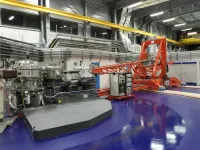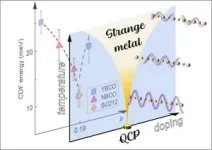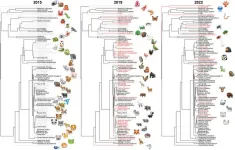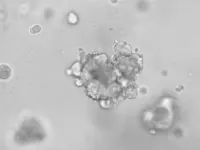(Press-News.org) Milan, December 11, 2023 - Taking a significant step forward in superconductivity research, the discovery could pave the way for sustainable technologies and contribute to a more environmentally friendly future.
The study just published in Nature Communications by researchers from Politecnico di Milano, Chalmers University of Technology in Göteborg and Sapienza University of Rome sheds light on one of the many mysteries of high-critical-temperature copper-based superconductors: even at temperatures above the critical temperature, they are special, behaving like "strange" metals. This means that their electrical resistance changes with temperature differently than that of normal metals.
The research hints at the existence of a quantum critical point connected to the phase called "strange metal". “A quantum critical point identifies specific conditions where a material undergoes a sudden change in its properties due solely to quantum effects. Just like ice melts and becomes liquid at zero degrees Celsius due to microscopic temperature effects, cuprates turn into a 'strange' metal because of quantum charge fluctuations” commented Riccardo Arpaia, researcher at the Department of Microtechnology and Nanoscience at Chalmers and leading author of the study.
The research is based on X-ray scattering experiments conducted at the European Synchrotron ESRF and at the British synchrotron DLS. They reveal the existence of charge density fluctuations affecting the electrical resistance of cuprates in such a way as to make them "strange". The systematic measurement of how the energy of these fluctuations varies allowed identifying the value of the charge carrier density at which this energy is minimum: the quantum critical point.
"This is the result of more than five years of work. We used a technique, called RIXS, largely developed by us at the Politecnico di Milano. Thanks to numerous measurement campaigns and to new data analysis methods, we were able to prove the existence of the quantum critical point. A better understanding of cuprates will guide the design of even better materials, with higher critical temperatures, and therefore easier to exploit in tomorrow's technologies" adds Giacomo Ghiringhelli, Professor at the Physics Department of the Politecnico di Milano and coordinator of the research.
Sergio Caprara, together with his colleagues at the Department of Physics of Sapienza University of Rome, came up with the theory that assigns to charge fluctuations a key role in cuprates. He declared “This discovery represents an important advancement in understanding not only the anomalous properties of the metallic state of cuprates, but also the still obscure mechanisms underlying high-temperature superconductivity”.
LINK article: Signature of quantum criticality in cuprates by charge density fluctuations
Chalmers University of Technology in Gothenburg, Sweden, conducts research and education in technology and natural sciences at a high international level. The university has 3100 employees and 10,000 students, and offers education in engineering, science, shipping and architecture. With scientific excellence as a basis, Chalmers promotes knowledge and technical solutions for a sustainable world. Through global commitment and entrepreneurship, we foster an innovative spirit, in close collaboration with wider society. Chalmers was founded in 1829 and has the same motto today as it did then: Avancez – forward.
Press contacts:
Politecnico di Milano
Media Relations
Francesca Pierangeli
02 2399.2441 – 3666211435
relazionimedia@polimi.it
Sapienza Università di Roma
Stampa e comunicazione
Alessandra Bomben
06 49910035-0034 - 3669243921
stampa@uniroma1.it
Chalmers University of Technology
Press Office
Karin Wik
+46-31-772 2062
press@chalmers.se
END
A cause for the "strange" behavior of cuprates discovered - a step towards more sustainable superconductor applications
The study by Politecnico di Milano, Chalmers University of Technology, and Sapienza University of Rome, published in Nature Communications
2023-12-11
ELSE PRESS RELEASES FROM THIS DATE:
Know Diabetes by Heart™ collaborative awards funding for community education
2023-12-11
ARLINGTON, VA and DALLAS, December 11, 2023 — The American Diabetes Association® and the American Heart Association® have awarded grants to 10 community organizations to help people living with Type 2 diabetes lower their risk for cardiovascular diseases like heart attack, heart failure and stroke.
The community grants are part of the leading health non-profits’ joint Know Diabetes by Heart™ initiative which seeks to reduce cardiovascular events and deaths among people living with Type 2 diabetes. The grants will help organizations in California, Florida, Georgia, ...
Hodgkin lymphoma prognosis, biology tracked with circulating tumor DNA
2023-12-11
A Stanford Medicine-led, international study of hundreds of samples from patients with Hodgkin lymphoma has shown that levels of tumor DNA circulating in their blood can identify who is responding well to treatment and others who are likely to experience a disease recurrence — potentially letting some patients who are predicted to have favorable outcomes forgo lengthy treatment.
Surprisingly, the study also revealed that Hodgkin lymphoma, a cancer of the lymph nodes, can be divided into two groups, each with distinct genetic changes and slightly different prognoses. These changes hint ...
Nature and animal emojis don’t accurately represent natural biodiversity—Researchers say they should
2023-12-11
The current emoji library doesn’t accurately represent the “tree of life” and the breadth of biodiversity seen in nature according to an analysis presented December 11 in the journal iScience. A team of conservation biologists categorized emojis related to nature and animals and mapped them onto the phylogenetic tree of life. They found that animals are well represented by the current emoji catalog, whereas plants, fungi, and microorganisms are poorly represented. Within the animal kingdom, vertebrates were overrepresented while arthropods were underrepresented with respect to their actual biodiversity. The researchers argue that creating a more diverse and representative ...
Adolescent body mass index and early chronic kidney disease in young adulthood
2023-12-11
About The Study: High body mass index (BMI) in late adolescence was associated with early chronic kidney disease in young adulthood in this study that included 593,000 adolescents. The risk was also present in seemingly healthy individuals with high-normal BMI and before 30 years of age, and a greater risk was seen among those with severe obesity. These findings underscore the importance of mitigating adolescent obesity rates and managing risk factors for kidney disease in adolescents with high BMI.
Authors: Gilad Twig, M.D., Ph.D., of the Israel Defense Forces, Medical Corps, Tel Hashomer, Ramat Gan, Israel, is the corresponding author.
To ...
Prenatal exposure to GLP-1 receptor agonists and other second-line antidiabetics may not pose greater risk to infants than insulin
2023-12-11
Embargoed for release: Monday, December 11, 11:00 AM ET
Key points:
In a study of 3.5 million pregnancies across four countries between 2009 and 2021, researchers observed no elevated risk of major congenital malformations, including major cardiac malformations, among infants born to pregnant women with pre-gestational type 2 diabetes who took second-line non-insulin antidiabetic medications compared with those who took insulin.
The researchers observed an increase in use of second-line non-insulin antidiabetic ...
Potential new treatment for pulmonary neuroendocrine tumors
2023-12-11
The Organoid Group (Hubrecht Institute) and the Rare Cancers Genomics Team (IARC/WHO) found a way to grow samples of different types of neuroendocrine tumors (NETs) in the lab. While generating their new model, the researchers discovered that some pulmonary NETs need the protein EGF to be able to grow. These types of tumors may therefore be treatable using inhibitors of the EGF receptor. The results were published in Cancer Cell on 11 December 2023.
Neuroendocrine tumors
Neuroendocrine tumors (NETs) are relatively ...
AI chatbot shows potential as diagnostic partner, researchers find
2023-12-11
BOSTON – Physician-investigators at Beth Israel Deaconess Medical Center (BIDMC) compared a chatbot’s probabilistic reasoning to that of human clinicians. The findings, published in JAMA Network Open, suggest that artificial intelligence could serve as useful clinical decision support tools for physicians.
“Humans struggle with probabilistic reasoning, the practice of making decisions based on calculating odds,” said the study’s corresponding author Adam Rodman, MD, an internal medicine physician and investigator in ...
Health impacts of abuse more extensive than previously thought, research says
2023-12-11
People who have been subject to abuse are more likely to experience physical and mental health effects than previously thought, according to a new study.
In a global review and meta-analysis of evidence published in Nature Medicine today, researchers have found that there are elevated risks between intimate partner violence or childhood sexual abuse, and some health conditions including major depressive disorder, maternal miscarriage for partners, and alcohol misuse and self-harm among children.
Globally, one in three ever-partnered women have experienced ...
Made-to-order diagnostic tests may be on the horizon
2023-12-11
McGill University researchers have made a breakthrough in diagnostic technology, inventing a ‘lab on a chip’ that can be 3D-printed in just 30 minutes. The chip has the potential to make on-the-spot testing widely accessible.
As part of a recent study, the results of which were published in the journal Advanced Materials, the McGill team developed capillaric chips that act as miniature laboratories. Unlike other computer microprocessors, these chips are single-use and require no external power source—a simple paper strip suffices. They function through capillary action – ...
Have researchers found the missing link that explains the mysterious phenomenon known as fairy circles?
2023-12-11
BEER-SHEVA, Israel, December 11, 2023 – Fairy circles, a nearly hexagonal pattern of bare-soil circular gaps in grasslands, initially observed in Namibia and later in other parts of the world, have fascinated and baffled scientists for years. Theories for their appearance range from spatial self-organization induced by scale-dependent water-vegetation feedback to pre-existing patterns of termite nests.
Prof. Ehud Meron of Ben-Gurion University of the Negev has been studying the Namibian fairy circles as a case study for understanding how ecosystems respond to water stress. He believes that all theories ...
LAST 30 PRESS RELEASES:
New software sheds light on cancer’s hidden genetic networks
UT Health San Antonio awarded $3 million in CPRIT grants to bolster cancer research and prevention efforts in South Texas
Third symposium spotlights global challenge of new contaminants in China’s fight against pollution
From straw to soil harmony: International team reveals how biochar supercharges carbon-smart farming
Myeloma: How AI is redrawing the map of cancer care
Manhattan E. Charurat, Ph.D., MHS invested as the Homer and Martha Gudelsky Distinguished Professor in Medicine at the University of Maryland School of Medicine
Insilico Medicine’s Pharma.AI Q4 Winter Launch Recap: Revolutionizing drug discovery with cutting-edge AI innovations, accelerating the path to pharmaceutical superintelligence
Nanoplastics have diet-dependent impacts on digestive system health
Brain neuron death occurs throughout life and increases with age, a natural human protein drug may halt neuron death in Alzheimer’s disease
SPIE and CLP announce the recipients of the 2025 Advanced Photonics Young Innovator Award
Lessons from the Caldor Fire’s Christmas Valley ‘Miracle’
Ant societies rose by trading individual protection for collective power
Research reveals how ancient viral DNA shapes early embryonic development
A molecular gatekeeper that controls protein synthesis
New ‘cloaking device’ concept to shield sensitive tech from magnetic fields
Researchers show impact of mountain building and climate change on alpine biodiversity
Study models the transition from Neanderthals to modern humans in Europe
University of Phoenix College of Doctoral Studies releases white paper on AI-driven skilling to reduce burnout and restore worker autonomy
AIs fail at the game of visual “telephone”
The levers for a sustainable food system
Potential changes in US homelessness by ending federal support for housing first programs
Vulnerability of large language models to prompt injection when providing medical advice
Researchers develop new system for high-energy-density, long-life, multi-electron transfer bromine-based flow batteries
Ending federal support for housing first programs could increase U.S. homelessness by 5% in one year, new JAMA study finds
New research uncovers molecular ‘safety switch’ shielding cancers from immune attack
Bacteria resisting viral infection can still sink carbon to ocean floor
Younger biological age may increase depression risk in older women during COVID-19
Bharat Innovates 2026 National Basecamp Showcases India’s Most Promising Deep-Tech Ventures
Here’s what determines whether your income level rises or falls
SCIE indexation achievement: Celebrate with Space: Science & Technology
[Press-News.org] A cause for the "strange" behavior of cuprates discovered - a step towards more sustainable superconductor applicationsThe study by Politecnico di Milano, Chalmers University of Technology, and Sapienza University of Rome, published in Nature Communications



